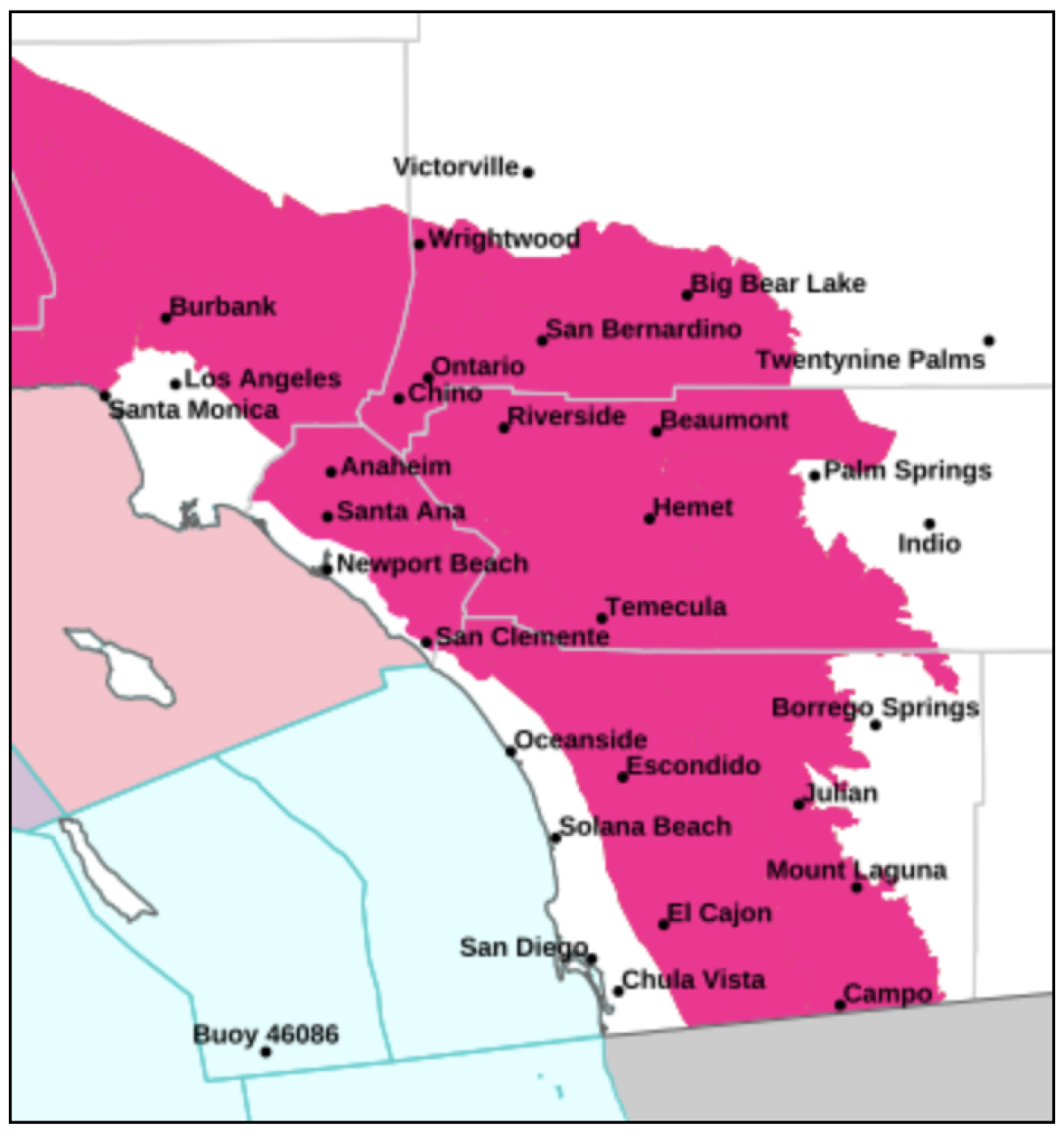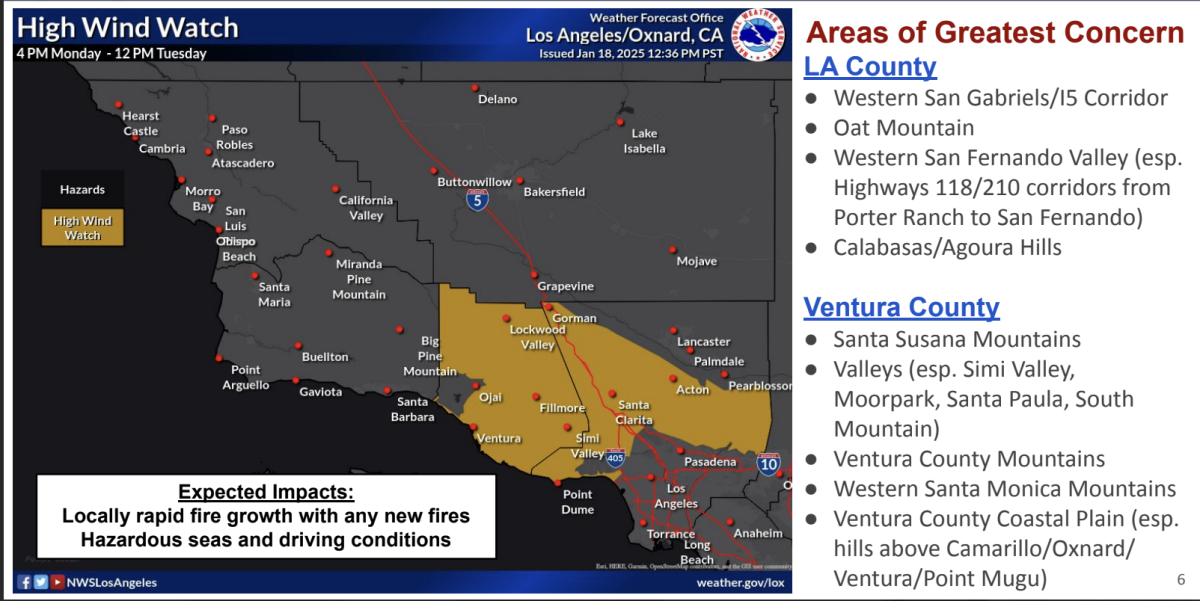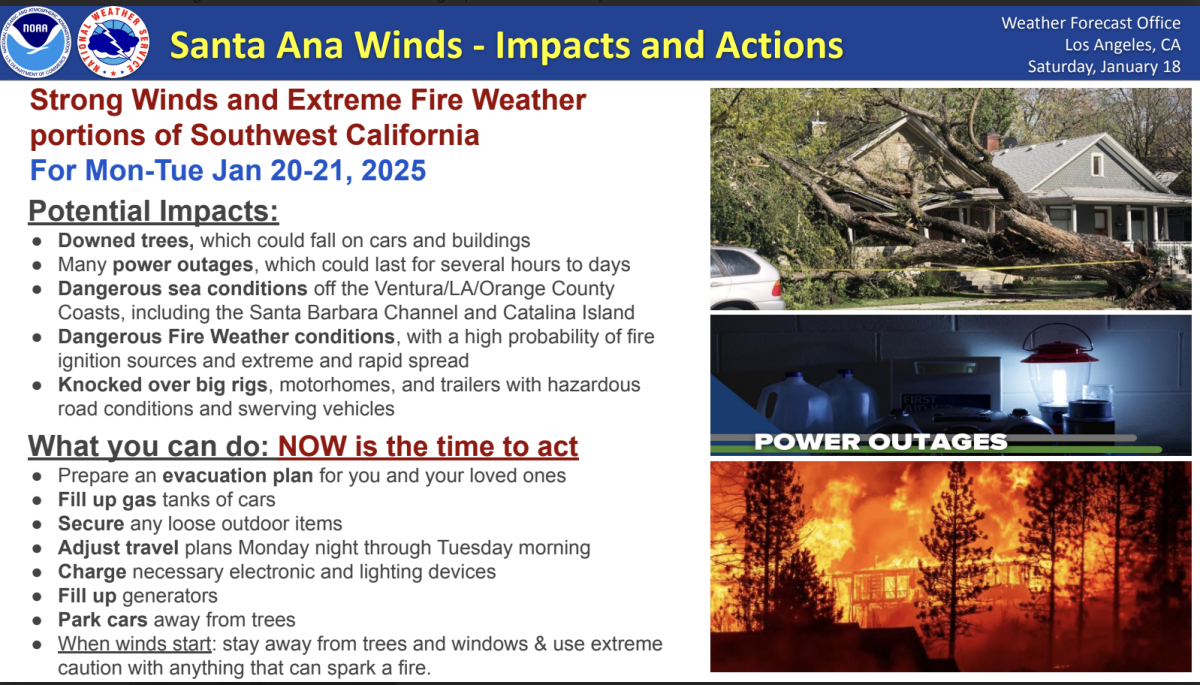
The Santa Ana wind forecast for Southern California has worsened, with officials saying the conditions will bring the “risk of large fire growth” beginning Monday.
The National Weather Service office in Oxnard on Sunday issued the most extreme version of its red flag fire weather warning, known as a “particularly dangerous situation” alert.
A large swath of Los Angeles and Ventura counties is likely to be affected, including burn areas in Malibu and Altadena, weather service meteorologists said. They warned residents to prepare for the event, which is expected to start at noon Monday and continue until 10 a.m. Tuesday.
Gusts of 50 to 70 mph are forecast for the coasts and valleys. In the mountains and foothills, gusts from 60 to 80 mph, with isolated gusts of 100 mph, are expected.
“We’d encourage people to prepare that evacuation plan for you, your loved one, pets — pack essentials, get that emergency go-bag ready just in case. Fill up gas for cars and generators, secure outdoor items and adjust travel plans,” said Rose Schoenfeld, a weather service meteorologist.
In addition to Malibu and Altadena, the warning includes Burbank, Santa Clarita, Oxnard, Thousand Oaks and Azusa. Ojai and Pasadena fall outside the boundary, Schoenfeld said.

The National Weather Service said its extreme version of a red flag warning would go into effect Monday for parts of L.A. and Ventura counties.
(National Weather Service)
A conventional red flag warning — indicating critical fire weather conditions and rapid fire spread with any new ignition — is already in effect for wide swaths of the counties of Los Angeles, San Diego, Orange, Riverside, San Bernardino and Ventura from 10 a.m. Monday through 10 p.m. Tuesday.
The new alert is an unprecedented fifth issuance of a “particularly dangerous situation” enhancement to a red flag warning in a single season by the weather service’s Oxnard office, which covers Los Angeles, Ventura, Santa Barbara and San Luis Obispo counties.
The first three times the office issued that warning were followed by fires igniting and spreading rapidly — the 19,904-acre Mountain fire in Ventura County in November, which razed 243 structures; the 4,037-acre Franklin fire, which spread rapidly in Malibu and destroyed 20 buildings in December; and this month’s Palisades and Eaton fires, among the most destructive and deadliest in modern California history.
The weather service in Oxnard started issuing “particularly dangerous situation” warnings only in 2020. It sent out two that year, in October and December. No others were issued until November 2024.
Over the weekend, firefighters raced against the new threat of powerful winds to increase containment of the wildfires still burning in Pacific Palisades and Altadena — areas that fall under the red flag warning.
As of Sunday, the Palisades fire, which has burned more than 23,700 acres and killed at least 10 people, was 56% contained, according to the state Department of Forestry and Fire Protection. The Eaton fire, which has charred more than 14,000 acres and killed at least 17 people, was 81% contained.
There are still 27 people reported missing: 20 from the Eaton fire and seven from the Palisades, according to the Los Angeles County Sheriff’s Department.
Late Sunday, there were still communities near the Palisades fire that remained under evacuation orders, though areas where residents, and only residents, were being allowed in had expanded to the Palisades Highlands, with daily escorts at 10 a.m. and 5 p.m. Evacuation warnings were lifted in other areas.
Meanwhile in Altadena, areas north of Mendocino and Harriet streets remained under evacuation orders. South of that, the area north of Woodbury Road between Lincoln Avenue, on the west, and Lake Avenue, on the east, was still under an evacuation warning Sunday night.
The Altadena sheriff’s station remained closed after concerns about airborne contaminants sparked a California Division of Occupational Safety and Health complaint last week, though Sheriff Robert Luna said Sunday that he expected it would reopen in the early part of this week.
More than 2,700 federal and state fire personnel continued to battle the Eaton fire Sunday — slightly fewer than the day before as some fire crews were relieved from duty. Carlos Herrera, L.A. County Fire Department public information officer, said officials would continue to release firefighters — who have come from all around the country as well as Canada and Mexico — as containment increases.
But the department will remain in communication with weather experts to staff appropriately, “especially in Altadena in Mt. Lowe and Mt. Wilson — some spots where we’re looking on getting containment,” Herrera said. “We have plenty of resources.”
At a Sunday afternoon town hall, Cal Fire Operations Section Chief Jed Gaines echoed that sentiment — but with a hint of concern in light of the forecast for the days ahead.
“We are confident that this fire is going to stay within the current footprint it sits today,” he said, “but we are concerned if there are new starts in the area.”
More than 5,600 fire personnel remained attached to the Palisades fire Sunday, roughly the same number as the day before.
Melanie Miller, the Palisades incident’s public information officer, said crews were doing “contingency planning” in preparation for more wind, and were in a waiting stage to see whether a change in action would be needed or if some resources could be released.
Other regions affected by the warning include Santa Monica and the San Gabriel Valley. Areas outside the red flag warning zone include the L.A. Basin, such as downtown L.A., Torrance and Long Beach, and coastal San Diego and Orange counties.
Malibu resident Kathy King was bracing for what might come with the winds.
“I’m concerned we’re going to have a replay of what we saw a week ago, 10 days ago,” she said Sunday while grocery shopping. “We know once a fire gets started, it’s very hard to turn it around.”
Her home near Point Dume survived the Woolsey fire in 2018, when nearly all the others on her street burned. But the Palisades fire destroyed the real estate office where she works in Pacific Palisades. The new weather warning has her on high alert.
“I can’t even sleep when they predict that because I think I’ve got to be ready to jump in the car,” King said.
Michelle Harrison and her husband lost their home in an unincorporated area of L.A. County just outside the Malibu city limits when the Palisades fire erupted Jan. 7.
Now, Harrison fears for those who could face even more threatening weather in Malibu this week.
“It’s just tragic,” she said. “I hope they have enough firefighters here, which I think they do now, to stop” any fires that might break out in the coming days.

Red flag warnings, which indicate critical fire weather and rapid spread should ignition occur, are expected to be in effect for large swaths of Los Angeles, San Diego, Orange, Riverside, San Bernardino and Ventura counties starting Monday.
(National Weather Service)
With this being more of a traditional Santa Ana wind event, which sees winds coming out of the east to northeast, Ventura County will be an area of great concern.
In L.A. County, the areas of greatest concern include the western San Fernando Valley, Calabasas, Agoura Hills, the western San Gabriel Mountains and the Grapevine section of Interstate 5.
Residents should secure loose outdoor items such as patio furniture; adjust travel times between Monday night and Tuesday morning; charge up electronics, flashlights and battery packs; fill up the fuel tanks of emergency generators; and move cars away from trees that appear fragile, Schoenfeld said.

(National Weather Service)
Experts warn people against keeping certain items within 5 feet of your home, such as outdoor furniture, umbrellas, garbage and recycling bins. Getting rid of all dead or living weeds is also a good idea, as is clearing gutters, roofs, decks, porches and stairways of flammable materials such as leaves and needles.
“And then when wind does start, stay away from trees, windows. And use extreme caution, again, with anything that could start a fire,” Schoenfeld said.

(National Weather Service)
Gusts could be so powerful they could knock over big rigs and motor homes and trigger power outages that could last days, the weather service said. And on Sunday evening, county public health officials issued a windblown dust and ash advisory, warning that the expected gusts could disperse ash throughout the county and reduce air quality — particularly in areas downwind of recent burn scars.
Very dry conditions are expected all week, with the driest Tuesday, the weather service said. Relative humidity could fall to as low as 5% in the western San Fernando Valley, Santa Clarita, Oxnard, Thousand Oaks and Fillmore.
Fire weather concerns will persist through the week, Schoenfeld said, with more Santa Ana winds possible by Thursday. The weather service could end the red flag warning Tuesday or extend it through Thursday.
There is some chance of rain in about a week. But, at this point, it doesn’t appear to be the kind of soaking that would be needed to end the fire season, Schoenfeld said.
There’s around a 50% to 70% chance of rain from Jan. 25 to 27, Schoenfeld said, and a 20% to 30% chance of thunderstorms.
“It doesn’t look like a really thoroughly wetting rain for a broad scope of the area,” Schoenfeld said. “That’s honestly bad news for our fire weather season going forward.”
Times staff writers Melody Gutierrez and Libor Jany contributed to this report.











Comments